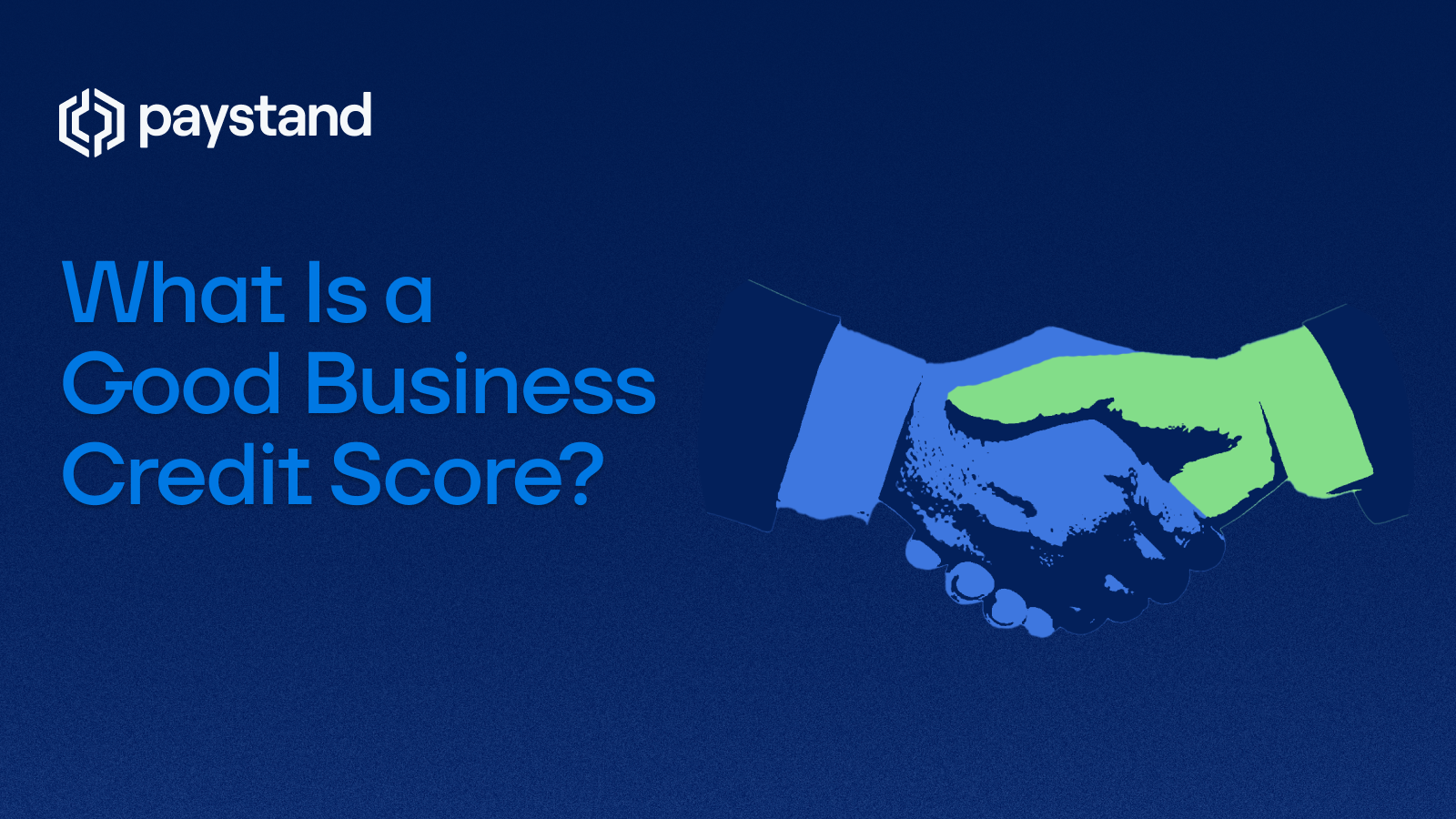What Is a Good Business Credit Score?

Table of Contents
- How Does a Business Credit Score Work?
- What Affects Your Business Credit Score?
- Where to Check Your Business Credit Score
- How Are Business Credit Scores Calculated?
- What Is a Good Business Credit Score?
- How to Achieve and Maintain Good Credit
Key Takeaways
- A good business credit score generally starts around 80 (D&B), 76 (Experian), or 700 (Equifax).
- Scores are influenced by payment history, credit utilization, and public records.
- Monitoring your business credit regularly helps prevent errors and fraud.
- Paying bills on time and keeping debt low are the fastest ways to improve credit.
- Automation tools and platforms like Paystand can help you manage expenses and payments more efficiently to protect your financial reputation.
Like your personal credit score, your business credit score determines your company’s financial credibility to credit bureaus, lenders, suppliers, and partners. A solid score unlocks better lines of credit, lower interest rates, and improved payment terms—while a weak one can limit your access to growth capital.
In this guide, we’ll break down what a good business credit score looks like, how it’s calculated, and what you can do to build and maintain strong business credit for long-term financial health.
How Does a Business Credit Score Work?
A business credit score is a number that reflects your company’s creditworthiness—how likely your business is to repay its debts. Unlike personal scores that range from 350–800, most business credit scores range from 0 to 100, though some (like the FICO Small Business Scoring Service, SBSS) go up to 300.
This score is built from your business credit history, which includes payment records, outstanding balances, and public records such as judgments or liens.
Good business credit means easier access to working capital, vendor financing, and partnerships. Learn more about how strong credit impacts your company’s cash flow in our guide to business financial management.
What Affects Your Business Credit Score?
Several factors determine your company’s credit profile:
- Payment History: On-time payments to lenders, suppliers, and credit cards have the largest impact. Late or missed payments hurt your score. (See why paying bills on time matters for AR teams)
- Credit Utilization Ratio: The percentage of credit used versus total available credit. Keeping utilization below 15% is ideal.
- Credit Age: The longer your credit history, the better.
- Public Records: Bankruptcies, liens, or judgments can lower your score.
- Industry Risk: Certain industries—like restaurants or real estate—are deemed higher risk by credit bureaus.
- Company Size and Revenue: Larger, more stable companies are typically scored more favorably.
Your credit card habits also influence your credit. Understanding credit card processing fees and maintaining low utilization are key to preserving good business credit.
Where to Check Your Business Credit Score
You can check your business credit through several business credit bureaus, including:
- Dun & Bradstreet (D&B): Uses the PAYDEX score (0–100). A score of 80 or above means you typically pay bills on time or early.
- Equifax: Provides three reports: the Business Credit Risk Score (101–992), Business Failure Score (1000–1610), and a Payment Trend Index.
- Experian: Uses a 0–100 score range to rate business creditworthiness.
Each bureau has unique scoring models, but all evaluate payment behavior, tradelines, and public records. Be sure to monitor your business credit regularly to detect errors or fraud early.
How Are Business Credit Scores Calculated?
Each credit bureau has its own formula, but common factors include:
- Timely payments (your track record of paying bills on time)
- Outstanding balances and utilization ratio
- Length of business credit history
- Public filings (liens, judgments, bankruptcies)
- Business demographics (size, industry, SIC/NAICS codes)
These factors combine to give lenders a snapshot of your business’s financial health. For insights on how automation can strengthen financial performance, explore finance workflow automation.
What Is a Good Business Credit Score?
The definition of a “good” score depends on which scoring model is used:
| Credit Bureau | Score Range | Good Score Threshold | Meaning |
|---|---|---|---|
| Dun & Bradstreet PAYDEX | 0–100 | 80+ | Pays bills on time or early |
| Experian Intelliscore | 0–100 | 76+ | Low risk of default |
| Equifax Business Credit Risk | 101–992 | 700+ | Strong payment history |
| FICO SBSS | 0–300 | 160+ | Likely to qualify for SBA loans |
A good business credit score signals financial stability and makes your business more attractive to lenders and partners. According to the Small Business Administration, many lenders require an SBSS score of at least 160 for loan approval.
Learn how to avoid common pitfalls, like credit card holds or excessive debt, to keep your score high.
How to Achieve and Maintain Good Credit
Building business credit takes time—but consistent financial discipline makes it attainable.
- Pay Bills on Time: Timely payments are the single biggest factor in maintaining good credit.
- Lower Credit Utilization: Keep credit use under 15% and avoid maxing out cards.
- Separate Personal and Business Credit: Open business accounts to prevent overlap with your personal credit score.
- Establish Tradelines with Vendors: Partner with suppliers that report to business credit bureaus like D&B.
- Dispute Errors: Regularly check your credit reports for inaccuracies.
- Use Credit Strategically: Only take on credit you can repay comfortably.
- Leverage Automation: Streamline payments and ensure accuracy by digitizing your AR and AP processes—see how in accounts receivable challenges.
If you want to maintain visibility into spending and reduce risk, explore the pros and cons of credit cards and digital alternatives that offer more control and security, such as virtual corporate cards.
Build Financial Health for the Future
Strong business credit opens the door to better financing and stronger relationships with vendors and investors. As the economy shifts toward digital-first finance, staying proactive about your credit and your payment processes is essential.
Download the Top B2B Payment Trends eBook to see what’s shaping the future of business finance and how you can position your company for growth.







%20(1)%20(1).jpg?width=100&height=100&name=IMG_3752%20(1)%20(1)%20(1).jpg)